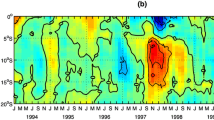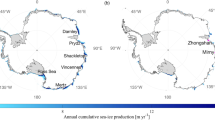Abstract
Spatial and temporal variability of nearshore winds in eastern boundary current systems is affected by orography, coastline shape, and air-sea interaction. These lead to a weakening of the wind close to the coast: the so-called wind drop-off. In this study, regional atmospheric simulations over the US West Coast are used to demonstrate monthly characteristics of the wind drop-off and assess the mechanisms controlling it. Using a long-term simulation, we show the wind drop-off has spatial and seasonal variability in both its offshore extent and intensity. The offshore extent varies from around 10 to 80 km from the coast and the wind reduction from 10 to 80 %. We show that when the mountain orography is combined with the coastline shape of a cape, it has the biggest influence on wind drop-off. The primary associated processes are the orographically-induced vortex stretching and the surface drag related to turbulent momentum flux divergence that has an enhanced drag coefficient over land. Orographically-induced tilting/twisting can also be locally significant in the vicinity of capes. The land-sea drag difference acts as a barrier to encroachment of the wind onto the land through turbulent momentum flux divergence. It turns the wind parallel to the shore and slightly reduces it close to the coast. Another minor factor is the sharp coastal sea surface temperature front associated with upwelling. This can weaken the surface wind in the coastal strip by shallowing the marine boundary layer and decoupling it from the overlying troposphere.













Similar content being viewed by others
References
Bakun A, Nelson CS (1991) The seasonal cycle of wind-stress curl in subtropical eastern boundary current regions. J Phys Oceanogr 21(12):1815–1834
Beardsley R, Dorman C, Rosenfeld L, Winan C (1987) Local atmospheric forcing during the Coastal Ocean Dynamics Experiment 1. A description of the marine boundary-layer and atmospheric conditions over a Northern California upwelling region. J Geophys Res 92:1467–1488
Beardsley RC, Enriquez AG, Friehe CA, Alessi CA (1997) Intercomparison of aircraft and buoy measurements of wind and wind stress during smile. J Atmos Oceanic Technol 14(4):969–977
Bentamy A, Fillon DC (2012) Gridded surface wind fields from metop/ascat measurements. Int J Remote Sens 33(6):1729–1754
Boé J, Hall A, Colas F, McWilliams JC, Qu X, Kurian J, Kapnick SB (2011) What shapes mesoscale wind anomalies in coastal upwelling zones? Clim Dyn 36(11–12):2037–2049
Capet X, Marchesiello P, McWilliams J (2004) Upwelling response to coastal wind profiles. Geophys Res Lett 31(13):L13311V1-L1331V4
Castelao RM (2012) Sea surface temperature and wind stress curl variability near a cape. J Phys Oceanogr 42(11):2073–2087
Chelton DB, Schlax MG, Samelson RM (2007) Summertime coupling between sea surface temperature and wind stress in the California current system. J Phys Oceanogr 37(3):495–517
Desbiolles F, Blanke B, Bentamy A, Grima N (2014) Origin of fine-scale wind stress curl structures in the benguela and canary upwelling systems. J Geophys Res 119(11):7931–7948
Dong C, McWilliams JC, Hall A, Hughes M (2011) Numerical simulation of a synoptic event in the Southern California Bight. J Geophys Res 116:C05018. doi:10.1029/2010JC006578
Dorman CE, Dever EP, Largier J, Koračin D (2006) Buoy measured wind, wind stress and wind stress curl over the shelf off Bodega Bay, California. Deep Sea Res Part II 53(25):2850–2864
Dorman CE, Winant CD (1995) Buoy observations of the atmosphere along the west coast of the united states, 1981–1990. J Geophys Res 100(C8):16 029–16 044
Dudhia J (1989) Numerical study of convection observed during the winter monsoon experiment using a mesoscale two-dimensional model. J Atmos Sci 46(20):3077–3107
Edwards KA, Rogerson AM, Winant CD, Rogers DP (2001) Adjustment of the marine atmospheric boundary layer to a coastal cape. J Atmos Sci 58(12):1511–1528
Epifanio CC, Rotunno R (2005) The dynamics of orographic wake formation in flows with upstream blocking. J Atmos Sci 62(9):3127–3150
FAO (2009) State of the World’s Fisheries and Aquaculture 2008. Food and Agriculture Organization of the United Nations
Gilhousen DB (1987) A field evaluation of ndbc moored buoy winds. J Atmos Oceanic Technol 4(1):94–104
Gruber N, Lachkar Z, Frenzel H, Marchesiello P, Münnich M, McWilliams JC, Nagai T, Plattner G-K (2011) Eddy-induced reduction of biological production in eastern boundary upwelling systems. Nat Geosci 4(11):787–792
Hong S-Y, Lim J-OJ (2006) The WRF single-moment 6-class microphysics scheme (WSM6). J Korean Meteorol Soc 42(2):129–151
Hong S-Y, Noh Y, Dudhia J (2006) A new vertical diffusion package with an explicit treatment of entrainment processes. Mon Weather Rev 134(9):2318–2341
Huyer A (1983) Coastal upwelling in the California current system. Prog Oceanogr 12(3):259–284
Jin X, Dong C, Kurian J, McWilliams JC, Chelton DB, Li Z (2009) SST-wind interaction in coastal upwelling: oceanic simulation with empirical coupling. J Phys Oceanogr 39(11):2957–2970
Kain JS, Fritsch JM (1990) A one-dimensional entraining/detraining plume model and its application in convective parameterization. J Atmos Sci 47(23):2784–2802
Marchesiello P, McWilliams JC, Shchepetkin A (2003) Equilibrium structure and dynamics of the California current system. J Phys Oceanogr 33(4):753–783
Mlawer EJ, Taubman SJ, Brown PD, Iacono MJ, Clough SA (1997) Radiative transfer for inhomogeneous atmospheres: RRTM, a validated correlated-k model for the longwave. J Geophys Res 102(D14):16 663–16 682
Nakanishi M, Niino H (2006) An improved Mellor-Yamada level-3 model: its numerical stability and application to a regional prediction of advection fog. Bound-Layer Meteorol 119(2):397–407
Park S, Bretherton CS (2009) The University of Washington shallow convection and moist turbulence schemes and their impact on climate simulations with the community atmosphere model. J Clim 22(12):3449–3469
Perlin N, Skyllingstad ED, Samelson RM (2011) Coastal atmospheric circulation around an idealized cape during wind-driven upwelling studied from a coupled ocean-atmosphere model. Mon Weather Rev 139(3):809–829
Perlin N, Skyllingstad ED, Samelson RM, Barbour PL (2007) Numerical simulation of air-sea coupling during coastal upwelling. J Phys Oceanogr 37(8):2081–2093
Perlin N, Skyllinstad ED ( 2013) Modeling of atmospheric flow around a coastal cape: Lee side story. arXiv preprint arXiv:1311.1860
Renault L, Dewitte B, Falvey M, Garreaud R, Echevin V, Bonjean F (2009) Impact of atmospheric coastal jet off Central Chile on sea surface temperature from satellite observations (2000–2007). J Geophys Res 114:C08006. doi:10.1029/2008JC005083
Renault L, Frenzel H, Colas F, Liang JH, Deutsch C, McWilliams JC (2014) How coastal wind profiles control the primary production off the Californian upwelling ? To be submitted
Renault L, Dewitte B, Marchesiello P, Illig S, Echevin V, Cambon G, Ramos M, Astudillo O, Minnis P, Ayers JK (2012) Upwelling response to atmospheric coastal jets off Central Chile: a modeling study of the October 2000 event. J Geophys Res 117:C02030. doi:10.1029/2011JC007446
Rotunno R, Smolarkiewicz PK (1995) Vorticity generation in the shallow-water equations as applied to hydraulic jumps. J Atmos Sci 52(3):320–330
Saha S et al (2010) The NCEP climate forecast system reanalysis. Bull Am Meteorol Soc 91(8):1015–1057
Skamarock W, Klemp J, Dudhia J, Gill D, Barker D (2008) A description of the Advanced Research WRF version 3. Tech. rep., NCAR/TN-4751STR
Smolarkiewicz PK, Rotunno R (1989) Low Froude number flow past three-dimensional obstacles. Part I: Baroclinically generated lee vortices. J Atmos Sci 46(8):1154–1164
Stark JD, Donlon CJ, Martin MJ, McCulloch ME (2007) OSTIA: an operational, high resolution, real time, global sea surface temperature analysis system. OCEANS 2007-Europe, IEEE, pp 1–4
Winant C, Dorman C, Friehe C, Beardsley R (1988) The marine layer off northern California: an example of supercritical channel flow. J Atmos Sci 45(23):3588–3605
Acknowledgments
The QuikSCAT winds were obtained from CERSAT at IFREMER (Plouzan, France). We appreciate support from the Office of Naval Research (ONR N00014-12-1-0939), the National Science Foundation (OCE-1419450), the California Energy Commission, and the California Institute of Energy and the Environment (500-11-033). The anonymous reviewer is thanked for her/his constructive comments and suggestions, which helped to improve the manuscript.
Author information
Authors and Affiliations
Corresponding author
Rights and permissions
About this article
Cite this article
Renault, L., Hall, A. & McWilliams, J.C. Orographic shaping of US West Coast wind profiles during the upwelling season. Clim Dyn 46, 273–289 (2016). https://doi.org/10.1007/s00382-015-2583-4
Received:
Accepted:
Published:
Issue Date:
DOI: https://doi.org/10.1007/s00382-015-2583-4




